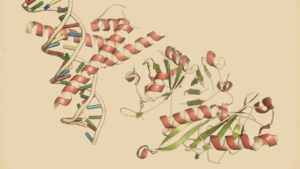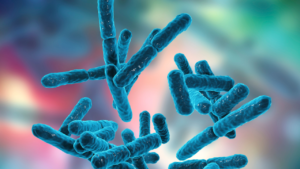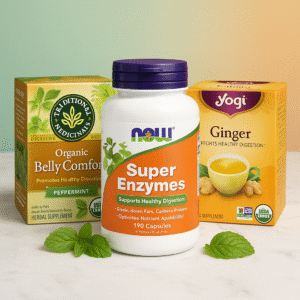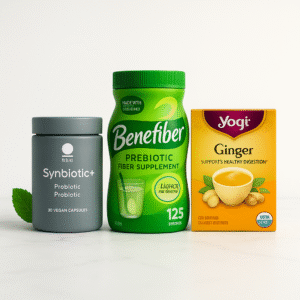8 Sources of Prebiotic Dietary Fibers For Better Health
Prebiotic dietary fibers offer different health benefits. FOS, inulin, and GOS are well-known prebiotics, while other compounds also provide health benefits.

There are several categories of prebiotic dietary fibers that offer distinct health benefits.
While FOS (fructooligosaccharides), inulin, and GOS (galactooligosaccharides) have been recognized as prebiotics for a long time, there are many other categories and compounds that provide health benefits to consumers, albeit with varying levels of effectiveness.
Based on the available evidence, the following eight categories of prebiotic dietary fibers are shown to promote digestive health for consumers.
Best 2 Prebiotic Dietary Fibers & FAQs:
8 Sources of Prebiotic Dietary Fibers
Beta-Glucan
Beta-glucans are a type of soluble compound that can be found in the endosperm cell walls of cereal grains, as well as in foods such as mushrooms, algae, and other marine plants.
These compounds are composed of linear D-glucopyranosyl units with a mixture of β-(1-3) and β-(1-4) glycosidic linkages.
Oat and barley are currently the two highest dietary sources of beta-glucans✅, with varying effects on host GI health due to differences in branching and length✅.
Beta-glucans from barley have been implicated in lowering plasma cholesterol, improving lipid metabolism, and reducing glycemic index✅.
Oats are a rich source of beta-glucan and have been associated with reduced risk of cardiovascular disease✅.
Additionally, Beta-glucans have also been studied for their potential therapeutic properties, including antitumor, anti-inflammatory, and immunomodulating activities✅.
Fructooligosaccharides/Oligofructose/Inulin
Various foods and structures contain fructan compounds, specifically β[2-1]-fructans.
Inulin, which is a type of fructan, typically contains 3-60 fructan monomers.
Oligofructose is produced by chemically breaking down these compounds using endoglycosidase enzymes, resulting in a product with 2-20 fructan monomers✅.
Fructooligosaccharides (FOS), on the other hand, are created through the transfructosylation of sucrose and contain 2 and 4 β(2-1)-linked fructosyl units.
All of these compounds have strong bifidogenic effects, but the length of polymerization can impact these effects✅.
Fructooligosaccharides and inulin have been found to have potential anti-inflammatory and immunomodulatory effects✅.
They have also been shown to have positive effects on bone health, as they increase the absorption of calcium and other minerals✅.
Best Features:
- Climate Pledge Friendly
- USDA Organic
- B Certified
- Made Traceable
- 1 Billion CFUs
- Smart Capsule (Reach to Colon)
Why buy it
- Third-Party Tested
- 3 in1 (Prebiotic, Probiotics, Postbiotics)
- Enhance Immune System

Galactooligosaccharides
Galactooligosaccharides (GOS) are a combination of oligosaccharides that are produced by enzymatically modifying primary lactose using β-galactosidases✅.
The enzymatic reaction results in the synthesis of 2-10 molecules of galactose and 1 molecule of glucose✅.
The prebiotic capacity of GOS is determined by various factors such as purity, degree of polymerization, type, and dosage, which have been demonstrated in numerous clinical studies✅.
GOS consumption has been found to result in a highly specific bifidogenic response in humans, stimulating the growth of bifidobacteria in the intestine✅.
Isomaltooligosaccharides
Isomaltooligosaccharides (IMO) are a type of carbohydrate composed of glucose monomers linked by α(1-6)-glucosidic bonds.
They are produced by enzymatically treating cornstarch with α-amylase, pullulanase, and α-glucosidase✅, and contain isomaltose, isomaltotriose, and panose as their primary components.
Most people can consume effective doses ranging from 5-10g per day✅, although adults can tolerate doses as high as 30g per day with only mild gastrointestinal side effects✅.
IMOs have been found to promote the growth and proliferation of beneficial probiotic bacteria, according to research by Kim et al✅.
They have also been shown to enhance digestive health, decrease mucoid contents in the cecum, and regulate the microbiota of the intestine✅.
5. Guar Gum
Guar gum is a natural thickening agent that is extracted from the endosperm of the Cyamopsis tetragonolobus plant. It is made up of high molecular weight polysaccharides containing [1-4]-linked β-D-mannopyranosyl units with [1-6]-linked α-D-galactopyranosyl side chain residues ✅.
Guar gum is commonly used in a variety of food products including dairy, bakery, cereal, and meat products.
Studies have shown that guar gum can enhance glucose tolerance and lower postprandial blood glucose levels✅.
Moreover, it has been found to decrease weight gain, adiposity, liver fat, and blood glucose levels in rats that were fed a high-fat diet✅.
Lactulose
Lactulose is a disaccharide composed of galactosyl β(1-4) fructose, which is derived from lactose✅.
It is not digestible by mammalian enzymes and is not absorbed in the small intestine✅.
Although it is not naturally present in foods, several limited clinical studies have consistently demonstrated its beneficial effects due to the fermentation of these compounds.
Lactulose has been proven effective in treating hepatic encephalopathy. When combined with polyethylene glycol (PEG), it results in faster discharge from the hospital compared to lactulose alone, as demonstrated by Naderian et al. in 2017✅.
Moreover, lactulose has positive impacts on gut microbiota and short-chain fatty acid composition, as well as on the growth of Lactobacillus acidophilus and Bifidobacterium bifidum in yogurt✅.
Resistant Starches
Resistant starches are a group of starches that cannot be digested in the upper gastrointestinal tract.
Resistant maltodextrin, which is a type of resistant starch, is produced by treating cornstarch with various acid, enzymatic, and heating processes.
It is highly soluble in water and has low viscosity, making it useful in various applications.
Although some resistant starches occur naturally in foods, others are artificially produced✅.
Xylooligosaccharides & Arabinooligosaccharides
Xylooligosaccharides (XOS) are a type of carbohydrate composed of 2-10 xylose monomers linked with β 1-4 bonds, with DP ≤ 20.
They are commonly found in dairy products, cereals, bars, sports drinks, and isotonic beverages✅.
Human intervention studies have shown that doses of up to 12g/d are well-tolerated.
Japan is the largest producer and consumer of XOS, and it has been approved as an ingredient for "Food for Specified Health Use" since 1991. According to regulations, XOS is expected to have a specific effect on health✅.
Conclusion
Prebiotic dietary fibers have numerous health benefits for digestive health but should be consumed in moderation and with variety.
While FOS, inulin, and GOS are the traditional prebiotics with the most evidence of beneficial health effects due to their fermentation, other categories of compounds may be equally or more effective.
All eight categories of compounds can support digestive health through fermentation when taken in appropriate dosages.
Best Features:
- Vegan & Keto
- TGA-registered
- GMP Certified
- All-in-one Health Drink
- 75 Vitamins, Minerals
Why buy it
- Trusted Brand (Top Performers, Athletes, & Entrepreneurs)
- Backed by our Scientific Advisory Board
- Prebiotics + Probiotics

Key Takeaways
- Prebiotic dietary fibers offer distinct health benefits.
- Several categories of prebiotic dietary fibers, including FOS, inulin, GOS, beta-glucans, and others.
- Promotion of digestive health for consumers through prebiotic dietary fibers.
Frequently Asked Questions
What are some good sources of prebiotic dietary fibers?
Chicory root: This is one of the richest sources of inulin, a type of prebiotic fiber that promotes the growth of beneficial gut bacteria.
Jerusalem artichoke: This root vegetable is also high in inulin and has a slightly sweet, nutty flavor.
Garlic: Garlic contains fructooligosaccharides (FOS), which are prebiotic fibers that help feed the good bacteria in your gut.
Onions: Like garlic, onions are a good source of FOS and can also help promote healthy digestion.
Asparagus: This vegetable is high in inulin and also contains other types of prebiotic fibers like fructooligosaccharides (FOS) and galactooligosaccharides (GOS).
Bananas: Bananas contain resistant starch, a type of prebiotic fiber that resists digestion and helps promote the growth of beneficial gut bacteria.
Oats: Oats are a good source of beta-glucans, a type of prebiotic fiber that helps support the growth of healthy gut bacteria.
Flaxseed: Flaxseed is high in both soluble and insoluble fiber, including prebiotic fibers like oligosaccharides and lignans.
How much prebiotic fiber should I consume per day?
Are there any side effects of consuming too much prebiotic fiber?
References
Fitnature uses only high-quality sources, including peer-reviewed studies, to support the facts within our articles. Read our editorial process to learn more about how we fact-check and keep our content accurate, reliable, and trustworthy.
- Bashir, Khawaja Muhammad Imran, and Jae-Suk Choi. “Clinical and Physiological Perspectives of β-Glucans: The Past, Present, and Future.” International Journal of Molecular Sciences, vol. 18, no. 9, Sept. 2017, https://doi.org/10.3390/ijms18091906.
- Bouhnik, Y., et al. “Prospective, Randomized, Parallel‐group Trial to Evaluate the Effects of Lactulose and Polyethylene Glycol‐4000 on Colonic Flora in Chronic Idiopathic Constipation.” Alimentary Pharmacology & Therapeutics, vol. 19, no. 8, pp. 889–99, https://doi.org/10.1111/j.1365-2036.2004.01918.x. Accessed 11 July 2023.
- Carlson, Justin L., et al. “Health Effects and Sources of Prebiotic Dietary Fiber.” Current Developments in Nutrition, vol. 2, no. 3, Mar. 2018, p. nzy005, https://doi.org/10.1093/cdn/nzy005.
- Cloetens, Lieselotte, et al. “Role of Dietary Beta-Glucans in the Prevention of the Metabolic Syndrome – PubMed.” Nutrition Reviews, vol. 70, no. 8, Aug. 2012, https://doi.org/10.1111/j.1753-4887.2012.00494.x.
- Crittenden, R. G., and M. J. Playne. “Production, Properties and Applications of Food-Grade Oligosaccharides.” Trends in Food Science & Technology, vol. 7, no. 11, Nov. 1996, pp. 353–61, https://doi.org/10.1016/s0924-2244(96)10038-8.
- Davis, Lauren M. G., et al. “Barcoded Pyrosequencing Reveals That Consumption of Galactooligosaccharides Results in a Highly Specific Bifidogenic Response in Humans.” PLOS ONE, vol. 6, no. 9, Sept. 2011, https://doi.org/10.1371/journal.pone.0025200.
- de Wiele, T. van, et al. “Inulin-Type Fructans of Longer Degree of Polymerization Exert More Pronounced in Vitro Prebiotic Effects – PubMed.” Journal of Applied Microbiology, vol. 102, no. 2, Feb. 2007, https://doi.org/10.1111/j.1365-2672.2006.03084.x.
- Fåk, Frida, et al. “The Physico-Chemical Properties of Dietary Fibre Determine Metabolic Responses, Short-Chain Fatty Acid Profiles and Gut Microbiota Composition in Rats Fed Low- and High-Fat Diets.” PLOS ONE, vol. 10, no. 5, May 2015, https://doi.org/10.1371/journal.pone.0127252.
- Fancher, Courtney A., et al. “Avian Pathogenic Escherichia Coli and Clostridium Perfringens: Challenges in No Antibiotics Ever Broiler Production and Potential Solutions.” Microorganisms, vol. 8, no. 10, Oct. 2020, https://doi.org/10.3390/microorganisms8101533.
- Gupta, Mahesh, et al. “Barley for Brewing: Characteristic Changes during Malting, Brewing and Applications of Its By‐Products.” Comprehensive Reviews in Food Science and Food Safety, vol. 9, no. 3, pp. 318–28, https://doi.org/10.1111/j.1541-4337.2010.00112.x. Accessed 11 July 2023.
- Ho, ang V. T. Ho, et al. “The Effect of Oat β-Glucan on LDL-Cholesterol, Non-HDL-Cholesterol and apoB for CVD Risk Reduction: A Systematic Review and Meta-Analysis of Randomised-Controlled Trials.” British Journal of Nutrition, vol. 116, no. 8, pp. 1369–82, https://doi.org/10.1017/S000711451600341X. Accessed 11 July 2023.
- Hung, Tran Van, and Takuya Suzuki. “Dietary Fermentable Fiber Reduces Intestinal Barrier Defects and Inflammation in Colitic Mice.” The Journal of Nutrition, vol. 146, no. 10, Oct. 2016, pp. 1970–79, https://doi.org/10.3945/jn.116.232538.
- Kaminski, K. “Dielectric Studies on Mobility of the Glycosidic Linkage in Seven Disaccharides.” ACS Publications, 13 Sept. 2008, https://pubs.acs.org/doi/10.1021/jp804240a. Accessed 11 July 2023.
- Kim, Jin Kyoung, et al. “Isolation of Dextran‐hydrolyzing Intestinal Bacteria and Characterization of Their Dextranolytic Activities.” Biopolymers, vol. 103, no. 6, pp. 321–27, https://doi.org/10.1002/bip.22615. Accessed 11 July 2023.
- Lam, Ka-Lung, and Peter Chi-Keung Cheung. “Non-Digestible Long Chain Beta-Glucans as Novel Prebiotics.” Bioactive Carbohydrates and Dietary Fibre, vol. 2, no. 1, July 2013, pp. 45–64, https://doi.org/10.1016/j.bcdf.2013.09.001.
- Lomax, Amy R., and Philip C. Calder. “Prebiotics, Immune Function, Infection and Inflammation: A Review of the Evidence.” British Journal of Nutrition, vol. 101, no. 5, pp. 633–58, https://doi.org/10.1017/S0007114508055608. Accessed 11 July 2023.
- Macfarlane, G. T., et al. “Bacterial Metabolism and Health-Related Effects of Galacto-Oligosaccharides and Other Prebiotics – PubMed.” Journal of Applied Microbiology, vol. 104, no. 2, Feb. 2008, https://doi.org/10.1111/j.1365-2672.2007.03520.x.
- Marín-Manzano, M. Carmen, et al. “Galacto-Oligosaccharides Derived from Lactulose Exert a Selective Stimulation on the Growth of Bifidobacterium Animalis in the Large Intestine of Growing Rats – PubMed.” Journal of Agricultural and Food Chemistry, vol. 61, no. 31, Aug. 2013, https://doi.org/10.1021/jf402218z.
- Mudgil, Deepak, et al. “Guar Gum: Processing, Properties and Food Applications-A Review.” Journal of Food Science and Technology, vol. 51, no. 3, Mar. 2014, pp. 409–18, https://doi.org/10.1007/s13197-011-0522-x.
- Naderian, Mohammadreza, et al. “Polyethylene Glycol and Lactulose versus Lactulose Alone in the Treatment of Hepatic Encephalopathy in Patients with Cirrhosis: A Non-Inferiority Randomized Controlled Trial.” Middle East Journal of Digestive Diseases (MEJDD), vol. 9, no. 1, Dec. 2016, pp. 12-19. doi: 10.15171/mejdd.2016.46.
- Rastall, R. A. “Functional Oligosaccharides: Application and Manufacture – PubMed.” Annual Review of Food Science and Technology, vol. 1, Jan. 2010, https://doi.org/10.1146/annurev.food.080708.100746.
- Roberfroid, Marcel B. “Introducing Inulin-Type Fructans.” British Journal of Nutrition, vol. 93, no. S1, pp. S13–25, https://doi.org/10.1079/BJN20041350. Accessed 11 July 2023.
- Sajilata, M. G., et al. “Resistant Starch-A Review – PubMed.” Comprehensive Reviews in Food Science and Food Safety, vol. 5, no. 1, Jan. 2006, https://doi.org/10.1111/j.1541-4337.2006.tb00076.x.
- Shang, Nan, and Jianping Wu. “Gut Microbiota, Probiotics, Prebiotics and Bone Health: A Review.” Journal of Food Bioactives, vol. 3, Sept. 2018, pp. 101–10, https://doi.org/10.31665/JFB.2018.3153.
- Vázquez, M. J., et al. “Xylooligosaccharides: Manufacture and Applications.” Trends in Food Science & Technology, vol. 11, no. 11, Nov. 2000, pp. 387–93, https://doi.org/10.1016/s0924-2244(01)00031-0.
- Wang, H. F., et al. “Use of Isomalto-Oligosaccharide in the Treatment of Lipid Profiles and Constipation in Hemodialysis Patients – PubMed.” Journal of Renal Nutrition : The Official Journal of the Council on Renal Nutrition of the National Kidney Foundation, vol. 11, no. 2, Apr. 2001, https://doi.org/10.1016/s1051-2276(01)92591-9.
- Zhai, Shixiang, et al. “Effect of Lactulose Intervention on Gut Microbiota and Short Chain Fatty Acid Composition of C57BL/6J Mice.” MicrobiologyOpen, vol. 7, no. 6, https://doi.org/10.1002/mbo3.612. Accessed 11 July 2023.
Review date not set.
How we reviewed this article:
Latest on:





